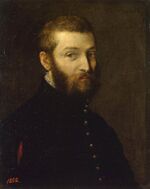The Venetian
The Venetian is one of the Masters of the Wisdom who lived in Venice for many years, hence the name. He stands at the Head of the Third Ray[1] and has been associated with the planet Saturn.
Physical characteristics
In an article written by Weller van Hook in 1921, he wrote:
The Venetian has for some centuries lived in Italy. He is not an old man; it was he who, giving the world the Rosicrucians--who are still active--taught the world through them, as an Egyptian might, the wonder of eternal youth, of deathlessness, of the Fountain from which flows everlasting youth. For centuries yet he will remain the Venetian, embodied as he is today. But though you would never have surmised it, he is by birth today a Fleming and not an Italian. By adoption and centuries of training, and by present affiliation and adoption, he is Italian; but Flanders and the Netherlands at large owe their especial blessings to his affection.[2]
C. W. Leadbeater described his physical appearance as follows:
Perhaps the Venetian Chohan is the handsomest of all the Members of the Brotherhood. He is very tall--about six feet five inches, and has a flowing beard and golden hair somewhat like those of the Manu; and His eyes are blue. Although He was born in Venice, His family undoubtedly has Gothic blood in its veins, for He is a man distinctly of that type.[3]
According to van Hook:
History called him Paul Veronese, because He was thought to have been born in Verona; but He has always been a master of mysteries, and it was no great task for Him to seem to have been born there and to live naturally under the name of Paul. And in that name He was avery great painter. Moreover, He it was who, with His Brothers' aid, poured Italy's cup full to over flowing with the golden glory of the Arts during several centuries.[4]
In one of these paintings He leaves a wonderful portrait of Himself in the physical body, although He has hidden His glory from us in many ways. Still He is there portrayed.[5]
Light on the Path
Accoring to C. W. Leadbeater, the Venetian Master was involved in the production of the book Light on the Path.
The Venetian Master translated [the original] aphorisms from Sanskrit into Greek, for the use of His Alexandrian pupils . . . [and] added to them certain explanations. . . . The rules now numbered 4, 8, 12, etc., are explanations and amplifications by the Venetian Master. . . . The beautiful little essay on Karma which appears at the end of the book is also from the hand of the Venetian Master, and was included in the book from the first edition.
The introduction to the second part [was also] written by the Venetian Master.[6]
Additional resources
- Besant, Annie, and Leadbeater, C. W. Man: Whence, How and Whither.
- Besant, Annie, and Leadbeater, C. W. The Lives of Alcyone.
- Venetian, The in Theosophy World.
Notes
- ↑ Charles Webster Leadbeater, The Masters and the Path, Chapter 12, "The Chohans of the Rays" (Adyar, Madras: The Theosophical Publishing House, 1992),
- ↑ Weller van Hook, "Some Artistic Labours of the Lord of the Cultural System," The Theosophist (December, 1921), 277.
- ↑ Charles Webster Leadbeater, The Masters and the Path, Chapter 2, "The Other Rays" (Adyar, Madras: The Theosophical Publishing House, 1992).
- ↑ Weller van Hook, "Some Artistic Labours of the Lord of the Cultural System," The Theosophist (December, 1921), 277.
- ↑ Weller van Hook, "Some Artistic Labours of the Lord of the Cultural System," The Theosophist (December, 1921), 278.
- ↑ Charles Webster Leadbeater, Talks on the Path of Occultism Volume 3, (Adyar, Madras: The Theosophical Publishing House, 1980).
